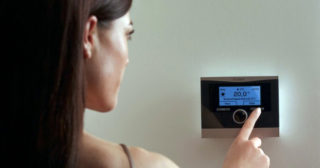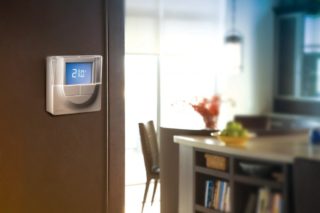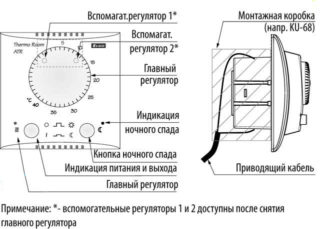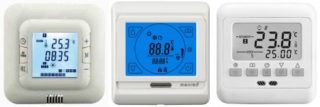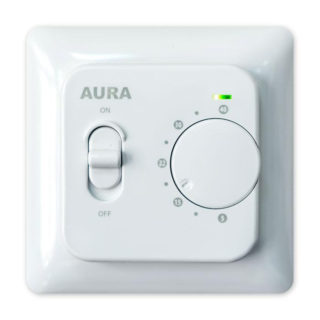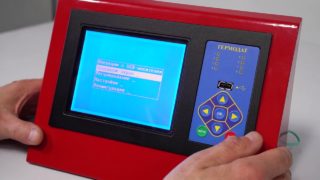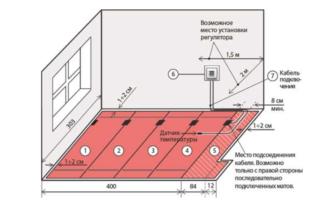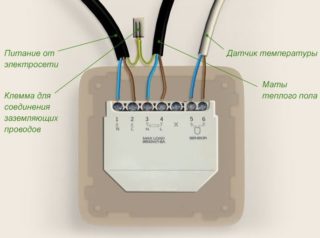To control the operating modes of heating systems, a special remote element is required that is not directly in contact with sensitive structural elements. This is a thermostat for a warm floor, which allows you to maintain the desired temperature of the flooring, depending on current needs. Knowledge of the principles of operation and types of devices will allow the user to choose and correctly mount the device in his apartment.
How thermostats for underfloor heating work
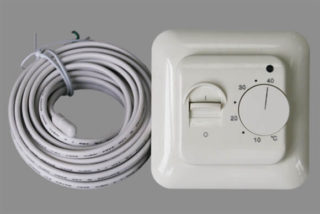
The main purpose of a thermostat for a warm floor is to monitor the condition and adjust the operating mode of the system of the same name. It consists of a control module and one or more remote sensors that record the current temperature distribution on the floor surface. With their help, information is transmitted to the regulator, which controls the connection and disconnection of individual sections of water pipes.
Thanks to the presence of this device in rooms, a comfortable temperature is maintained. In addition, the rational use of heat allows you to save on the consumption of electric energy.
Regulators of underfloor heating offered by domestic and foreign manufacturers are notable for their simplicity of design and ease of connection to existing systems. There are no difficulties when connecting them to the apartment electrical network. In the presence of such devices, the mode of operation of the system can be adjusted several times a day, without worrying about the operability of the device itself. The minimum floor temperature is set for each room separately. In addition, in some "advanced" models of regulators, it is possible to set the operating mode for a certain period.
Is their use mandatory?
If the main task of the buyer is to save on the arrangement and operation of the underfloor heating, the purchase and installation of a thermostat is not necessary at all. But when making this decision, the user loses the following features:
- set the required temperature, which is considered the most comfortable for the feet of adults, and especially children;
- change (adjust) the picture of the distribution of thermal zones depending on the current situation;
- Do not spend energy unnecessarily on heating areas of the floor covering that do not need it.
The use of a correctly configured temperature controller allows you to avoid another uncomfortable situation when the floor is very overheated. This usually happens when the temperature exceeds 25-27 degrees. In addition, strong heating negatively affects the upper (finishing) floor covering, since even the most heat-resistant varieties of it have an acceptable temperature limit.
If the temperature limits are exceeded, irreversible processes begin in the material, leading to linear expansion and deformation. At the same time, drying, warping and divergence of the seams with subsequent breakage of the castle joints are observed.
Regarding energy savings, the following important points must be considered:
- with proper installation, precise adjustment and proper operation of underfloor heating, the elements built into it consume energy unevenly;
- the maximum occurs at the time of starting the system and the initial heating of the coating to a given temperature;
- during subsequent operation, only short-term inclusions follow, which allow maintaining the desired level of surface heating.
Even without the use of an “intelligent” regulator, the total consumption is very small. When installing a well-tuned temperature regulator, the savings will reach record levels, since the floor in this case will only heat up when it is really needed.
Varieties of Regulators
The classic thermostat is a compact device, presented in the following versions:
- The model which is built in a wall connected to the hidden electrical wiring.
- In the form of an “open” product intended for installation directly on the wall (samples of the overhead type).
For operation in underfloor heating systems, this device is equipped with a special thermal sensor and signal cable. Some models also have their own built-in thermostat that controls the ambient temperature. They are used in situations where the electric floor system is the main source of heat (used instead of heating radiators).
The whole variety of modern temperature controllers for underfloor heating is divided into the following groups:
- electronic regulators;
- electromechanical devices;
- programmable devices with remote sensors;
- devices with remote control.
Electronic regulators
Devices of this class have a different performance from mechanical models, especially noticeable in their appearance. They are equipped with a digital display located on the front panel and buttons designed to accurately set the desired heating temperature. The Danfoss model is considered as an example of such a regulator, by means of which it is possible to precisely set the control parameter and visually monitor its current value. However, the functionality of the described sample is limited by this.
Electronic devices from well-known manufacturers (Electrolux, for example) are much more convenient to use in comparison with mechanical counterparts. However, their capabilities only slightly exceed the functionality of the latter. They do not provide any additional options (programming modes, for example, or non-volatile power supply), which are available only to "advanced" models. This limitation is the main reason for their small popularity.
Despite the relatively high cost, it is not possible to obtain significant savings in energy consumption when using electronic devices.
Mechanical models
Mechanical temperature controllers on the market are low-cost devices that are simple to design and maintain. The choice of control methods in these devices is not great. On their front panel, usually only two elements are placed - the power button and the temperature controller in the form of a wheel with a scale drawn next to it. In addition, it provides a simple indication of the on state, made on a regular LED.
The advantages of such regulators include simplicity of design and affordable price. However, the accuracy of setting the temperature regime is very low, which does not always allow achieving the desired result. Another significant drawback of these devices is the lack of options for programming operating modes.
Significant savings in energy consumed from the mains cannot be achieved through such a thermostat. Despite this, individual users are attracted by the simplicity of their device and affordable price.
Programmable devices
This group includes devices that are usually denoted by the word "smart", because they differ in the presence of a large number of options. As a rule, such devices provide for a separate built-in temperature sensor and the ability to switch the state monitoring modes in two environments (“by floor” and “by air”). But their main advantage is the ability to program the device as you wish, setting the desired temperature for a certain period of time. Usually they are set on the selected hours during the current day or on the days of the week (taking into account weekdays and weekends). Particularly “advanced” models of such regulators provide for the possibility of programming over a Wifi network with simultaneous connection to the Internet.
With remote control (with remote control)
This type of controllers is represented by models from Eberle, Gira and Livolo, consisting of two interconnected modules - stationary and portable (remote control). The first leads electrical wires from sensors and relays for underfloor heating, which determines the choice of location for its placement within the room. The operating modes of the heating system can be controlled from any zone limited by the range of the radio channel.
A number of manufacturers (“Livolo”, for example) release special applications for their products, having installed which it is possible to control the inclusion of equipment from a mobile phone. In some models of regulators, the remote control kit includes remote thermal sensors that measure the temperature of the air at their location.
Connection and adjustment of a temperature regulator
Before connecting the warm floor to the thermostat, thorough preparation is required, which is reduced to the following sequence of actions:
- Select a placement.
- Arrangement of auxiliary fixture or niche.
- Installation of the product.
To install the device, a place where sunlight does not fall is suitable. It is usually selected in an area where there are no drafts at a height of about 40 cm from the floor.
For the built-in thermostat, a niche is cut in the wall under the standard socket (its diameter is 68 mm). These sizes are enough to fit the thermostat itself and all groups of conductors connected to the terminals. After the wires are connected and the product body is fixed with the screws supplied with the kit, it remains to connect it, for which you will have to use the user manual.
If desired, switching cable cores is easy to figure out on your own. It is enough to carefully study the marking of the contacts.
Despite the variety of models on the market, the wiring diagram for most products of this class is approximately the same:
- the first two contacts are for power supply;
- heating elements of the “warm floor” are connected to the second pair;
- the third pair of terminals is used to connect the bus signal cable of the sensor.
The specified order (plan) of switching is not indicative of all types of regulators. When installing a particular device, nuances often arise, which are important to consider in advance.
Which temperature sensor to choose for a warm floor
To determine which temperature sensor for underfloor heating to choose for your apartment, the already considered classification by the principle of action will help. However, practice has shown that users prefer a slightly different approach to this issue. For many, the choice is made easier if the regulators are divided into groups according to the following criteria:
- affordability;
- technical level;
- latest design solutions.
First you need to get acquainted with the overview of the regulator models offered by the market and try to place them according to the preferences of customers.
Overview of some models
The models of the “popular luxury” segment offered by the domestic market include products presented by the company “Devi” (Denmark). The cost of these regulators is higher than that of conventional samples, but it is justified by high quality. The Danish manufacturer is positioning its models as a regular product without unnecessary frills. It does not form a long line of design decisions (like Legrand, for example), since the main task is reduced to a simple formula: I bought a device, installed it, and then set it up.
Another thing is products from the French company Legrand, distinguished by an exquisite design and many models compatible with the Valena series of switches.
The ABB product line is in high demand among consumers, characterized by wide functionality and quite affordable prices. Regulators presented by this company are equipped with a full range of air temperature sensors.
